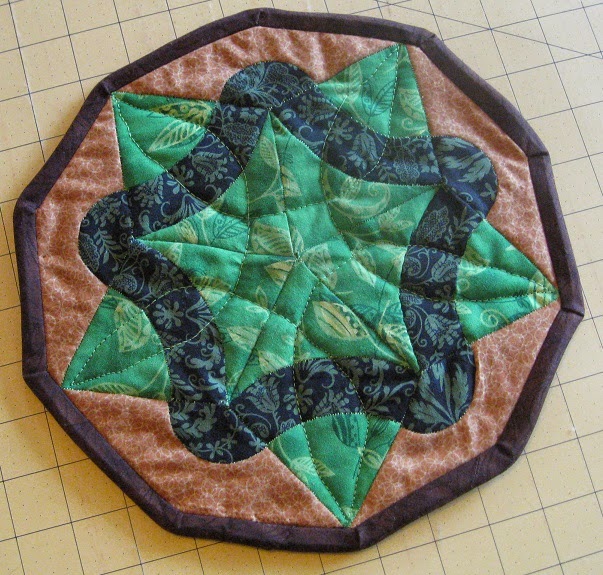It's based on a Penrose tiling, which is an aperiodic tiling derived from tiling pentagons. (I'll let wikipedia explain it).
I used a combination of machine piecing and English paper piecing to construct it using two types of diamonds:
and I lay them out in this base tiling:
Then I do two tricky things that exploit some of the niftier properties of Penrose tilings: matching rules and inflation/deflation. These need to be explained in more detail...
Constructing Penrose Tiling using Matching Rules
These rhombi (plural of rhombus, a fancy word for diamond) can be tiled in a lot of ways that are not actually Penrose tilings. They can be tiled in ways that are periodic, or completely non-periodic:
and you can certainly make some lovely quilts doing this:
 |
| This was made by Domesticat |
 |
| This was made by Dorothea |
My first plan was to design a quilt that copied the curved design as shown in the above diagram (but just the pink lines):
NOTE: Penrose tiling is beyond the powers of Electric Quilt, so I designed these using Geometer's Sketchpad instead.
I made this pot holder as a test to see if it was feasible to make the entire full sized quilt this way:
Although this was strictly feasible, I found that all the curved lines and sharp points made this too tricky for my skill level.
So I decided to tweak the matching rules into straight lines:
This way I can machine piece these straight lines first and paper piece the rhombi.
Constructing Penrose Tiling using Inflation/Deflation Properties
One of the mind-bending properties of a Penrose tiling is that if all the rhombi in a given tiling are broken up like so:
The resulting tiling is also a Penrose tiling of smaller tiles. In this example I deflate this simple tiling one level:
Now I can deflate this tiling down another level (I shaded a couple of rhombi from the previous level to illustrate this):
You can continue this indefinitely. Here's 3 and 4 level deflation:
The flip side of this is inflation; any tiling can be combined into larger tiles by reversing this process. So any tiling, no matter how large, is only a subset of a single rhombus (mind = blown).
This inspired me to design a quilt that exploits this property. I first thought it would be interesting to have a quilt that uses different sized rhombi:
Then I thought it would be cool if I designed a quilt where all the rhombi were the same size, but by using different colors and/or values (light and dark), an inflated level of Penrose tiling would emerge:
The combination of this design with the matching rule design above became the final design for the Christmas tree skirt:


















